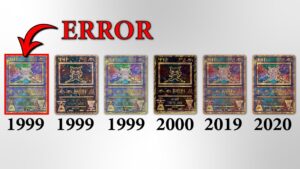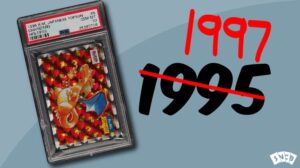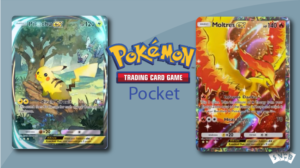Pokémon Card Storage Guide
-
By: Oliver Copeland
- Published:
- Last Updated: December 2, 2023
Most people are not correctly storing their Pokémon cards.
So you got into the world of Pokémon cards and your collection is growing out of control. Some of my friends have literal piles of Pokémon cards all over their houses. Not many collectors know that improper storage can lead to damaged or warped cards. In this article, we take a deep dive into card storage, protection, and proper care and handling.
Pokémon card sleeves
If for some reason you could only choose one product to protect your cards, it would have to be sleeves.
Sleeves are cheap, easy to use, and very effective at protecting trading cards. All a sleeve is, is a pocket of plastic that you slip your cards into, and they’re amazing.
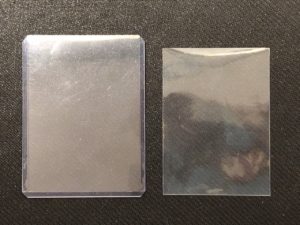
Any card that you care about, should be in a sleeve. It is wise to sleeve any holofoil cards immediately after you pull them from a booster pack. This will ensure that they are in the best condition possible for your collection or if you decide you want to have the card graded.
When buying sleeves, all you need to consider is size and brand. While most sleeve brands offer identical sleeves, we recommend Ultra Pro as they are the industry standard.
Sleeves come in many sizes. This is because some trading cards are unique in their size, such as Yu-Gi-Oh. Also, collectors have different preferences when it comes to fitment.
The most standard sleeve size is 2-⅝” X 3-⅝”. This will fit any trading card, including Pokémon. You can find these at most stores that sell cards. If you want a more snug fit, 2-1/2” X 3-1/2” sleeves will fit Pokémon cards perfectly. This is useful if you want to ‘double sleeve’ your cards or place them into binder pages.
Card binders crash course
There are good binders and bad binders.
You know the 3-ring binders that we used as kids? Those are the bad binders. It’s not your fault that you kept your cards in these, it’s what everyone used! But today, we have binders that are made specifically for trading cards and solve a handful of problems that came with the 3-ring setup.
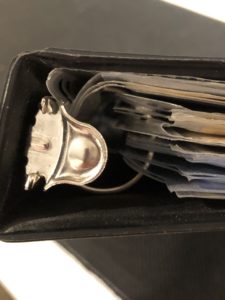
A good binder does not have rings, the pages are instead stitched into the binder itself. Unfortunately, this means you cannot add and remove pages, but it solves something much more important. On a 3-ring setup, pages can creep over the rings when the binder is closed, resulting in three indentations on three of your cards. The more pages to add to the binder, the greater risk. This is because the binder gets too full, and the pages are forced over the rings.
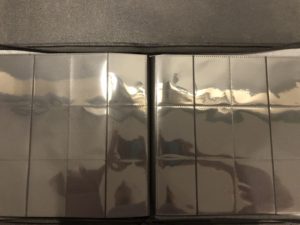
Now, onto the pages themselves. The good binders often have black pages with clear plastic stitched into the page, with side-loaded pockets.
You can purchase these pages separately if you insist on using a 3-ring binder. The pages are heavier, and the moment you hold them you realize that they are of much higher quality than the standard clear pages.
Side-loaded pockets vs. top-loaded pockets.
The standard clear pages that we all used as kids had the pocket opening on the top. This is fine but resulted in cards falling out of the binder if it was ever tipped upside-down.
Side-loaded pockets solve this issue, and the good binders and black pages are all side-loaded.
So there you go! Now you have an idea of proper binder practices for storing your Pokémon cards.
Pokémon card storage boxes
If you have a lot of cards to pack away, boxes are the best way to go.
This is good for bulk, or non-holofoil cards if you want to keep them organized. It’s also good for holofoil cards that are not as valuable, such as reverse holo cards.
What we’re referring to here are cardboard boxes that are folded in a way that offers multiple rows just wide enough for Pokémon cards. The boxes also come with a lid, so they are secure and stackable if needed.
Cards even fit nicely in these if you keep them in top loaders. The cardboard dividers that you get in the ETB can be helpful here as well.
Display units for Pokémon cards
You may be interested in displaying some of your more valuable or favorite Pokémon cards or booster packs. This is a good idea since most display cases also offer a lot of protection.
Acrylic cases are available for almost anything. If you have some booster packs you want to display or protect, acrylic cases are the best option because they offer so much protection. They look nice on display but are also capable of just being stacked in a box.
Frames are a great option if you want to display something. There are a lot of specially-made frames for Pokémon cards, booster packs, and other things. Some custom frames are available for graded cards, which look really nice on display.
You can also check your local thrift store for frames. Remember, if you plan on placing a card in a frame, it absolutely must be sleeved first!
Storage environment
If you’re storing your cards somewhere, it must be a cool and dry area.
Many elements can damage cards such as the sun, or humidity. UV rays can suck the color out of a card, resulting in a faded card.
Holofoil cards sometimes bend or curve. This happens because the card absorbs moisture from the air, and the card wants to expand, but the metal layer in the middle does not expand. If you want to know more about this, click here.
It should be obvious to keep your cards somewhere where your kids or pets can’t easily get to them, and away from moisture of any kind. They should not be anywhere near a water source like a sink or hot water tank.
Final thoughts
There are so many little details to consider when keeping your Pokémon cards long-term. We all learned a valuable lesson when the 1999 cards blew up in value, and most of us dug ours up to find damaged and abused collections. Let’s not make that mistake again. It’s highly important that cards are immediately sleeved and secured in a safe place. Pokémon card collecting is fun, but leaving stacks of cards around the house can lead to tears. Sleeve no card behind!

